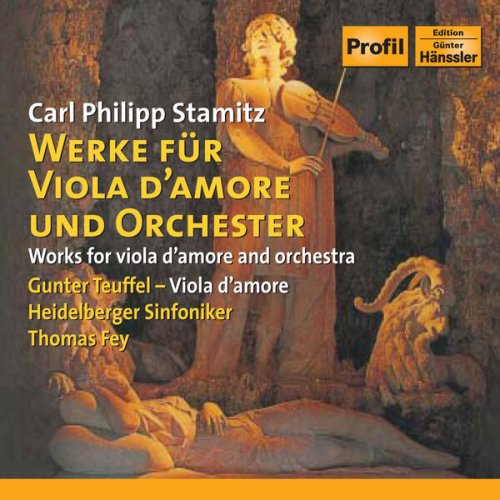Gunter Teuffel, Heidelberger Sinfoniker and Thomas Fey - Stamitz: Concertos & Sonata for Viola d'amore (2004)

Artist: Gunter Teuffel, Heidelberger Sinfoniker, Thomas Fey
Title: Stamitz: Concertos & Sonata for Viola d'amore
Year Of Release: 2004
Label: Profil
Genre: Classical
Quality: FLAC (tracks)
Total Time: 51:03
Total Size: 228 MB
WebSite: Album Preview
Tracklist:Title: Stamitz: Concertos & Sonata for Viola d'amore
Year Of Release: 2004
Label: Profil
Genre: Classical
Quality: FLAC (tracks)
Total Time: 51:03
Total Size: 228 MB
WebSite: Album Preview
1. Viola d'amore Concerto No. 1 in D Major: I. Allegro (09:09)
2. Viola d'amore Concerto No. 1 in D Major: II. Andante grazioso (02:36)
3. Viola d'amore Concerto No. 1 in D Major: III. Rondeaux (04:47)
4. Viola d'amore Concerto No. 2 in D Major: I. Allegro (10:07)
5. Viola d'amore Concerto No. 2 in D Major: II. Andante moderato (04:27)
6. Viola d'amore Concerto No. 2 in D Major: III. Rondo. Allegro (06:27)
7. Viola d'amore Sonata in E-Flat Major: I. Allegro (06:27)
8. Viola d'amore Sonata in E-Flat Major: II. Romance (02:13)
9. Viola d'amore Sonata in E-Flat Major: III. Allegro - Cantabile (04:47)
A touring phenomenon in the late eighteenth century, Carl Philipp Stamitz was more successful as a virtuoso on the viola d'amore than as a composer, though his enormous catalog of symphonies, symphonies concertantes, and concertos was impressive enough to provoke envy in Mozart. Yet Stamitz's music, like the works by his father, Johann Wenzel, and his brother, Anton, have often been lumped together as mediocre products of the Mannheim School -- important in the development of Classicism, but of less musical interest than the works of genius by Haydn and Mozart, and consequently less frequently played. On hearing the Concerto No. 1 in D major for viola d'amore and orchestra, the Concerto No. 2 in D major, and the Sonata in E flat major -- cleanly played in historically informed interpretations by Gunther Teuffel and the Heidelberg Symphony, conducted by Thomas Fey -- one may recognize the weaknesses of Stamitz's routine melodies, mechanical transitions, and limited developments. But at the same time, it is also easy to appreciate Stamitz's ingenuity in writing for his instrument, and to accept that his cheerful, showy music is not incompetent, but conventional for the time, and only deficient when compared to works by his superior contemporaries. Profil's sound quality is terrific.





![Tomasz Stańko - Piece for Diana and Other Ballads (Polish Radio Sessions vol. 1/6) (2025) [Hi-Res] Tomasz Stańko - Piece for Diana and Other Ballads (Polish Radio Sessions vol. 1/6) (2025) [Hi-Res]](https://www.dibpic.com/uploads/posts/2025-12/1765788761_cover.jpg)
![NYO Jazz - Live in Johannesburg (Live) (2025) [Hi-Res] NYO Jazz - Live in Johannesburg (Live) (2025) [Hi-Res]](https://www.dibpic.com/uploads/posts/2025-12/1765894703_zwp14vk90corb_600.jpg)

